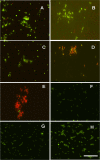Evaluation of different methods for extracting extracellular DNA from the biofilm matrix
- PMID: 19561191
- PMCID: PMC2725481
- DOI: 10.1128/AEM.00400-09
Evaluation of different methods for extracting extracellular DNA from the biofilm matrix
Abstract
The occurrence of high concentrations of extracellular DNA (eDNA) in the extracellular matrices of biofilms plays an important role in biofilm formation and development and possibly in horizontal gene transfer through natural transformation. Studies have been conducted to characterize the nature of eDNA and its potential function in biofilm development, but it is difficult to extract eDNA from the extracellular matrices of biofilms without any contamination from genomic DNA released by cell lysis during the extraction process. In this report, we compared several different extraction methods in order to obtain highly pure eDNA from different biofilm samples. After different extraction methods were explored, it was concluded that using chemical treatment or enzymatic treatment of biofilm samples may obtain larger amounts of eDNA than using the simple filtration method. There was no detectable cell lysis when the enzymatic treatment methods were used, but substantial cell lysis was observed when the chemical treatment methods were used. These data suggest that eDNA may bind to other extracellular polymers in the biofilm matrix and that enzymatic treatment methods are effective and favorable for extracting eDNA from biofilm samples. Moreover, randomly amplified polymorphic DNA analysis of eDNA in Acinetobacter sp. biofilms and Acinetobacter sp. genomic DNA and DNA sequencing analysis revealed that eDNA originated from genomic DNA but was not structurally identical to the genomic DNA.
Figures



References
-
- Allesen-Holm, M., K. B. Barken, L. Yang, M. Klausen, J. S. Webb, S. Kjelleberg, S. Molin, M. Givskov, and T. Tolker-Nielsen. 2006. A characterization of DNA release in Pseudomonas aeruginosa cultures and biofilms. Mol. Microbiol. 59:1114-1128. - PubMed
-
- Bockelmann, U., A. Janke, R. Kuhn, T. R. Neu, J. Wecke, J. R. Lawrence, and U. Szewzyk. 2006. Bacterial extracellular DNA forming a defined network-like structure. FEMS Microbiol. Lett. 262:31-38. - PubMed
-
- Bradford, M. M. 1976. A rapid and sensitive method for the quantitation of microgram quantities of protein utilizing the principle of protein-dye binding. Anal. Biochem. 72:248-254. - PubMed
Publication types
MeSH terms
Substances
LinkOut - more resources
Full Text Sources
Other Literature Sources

